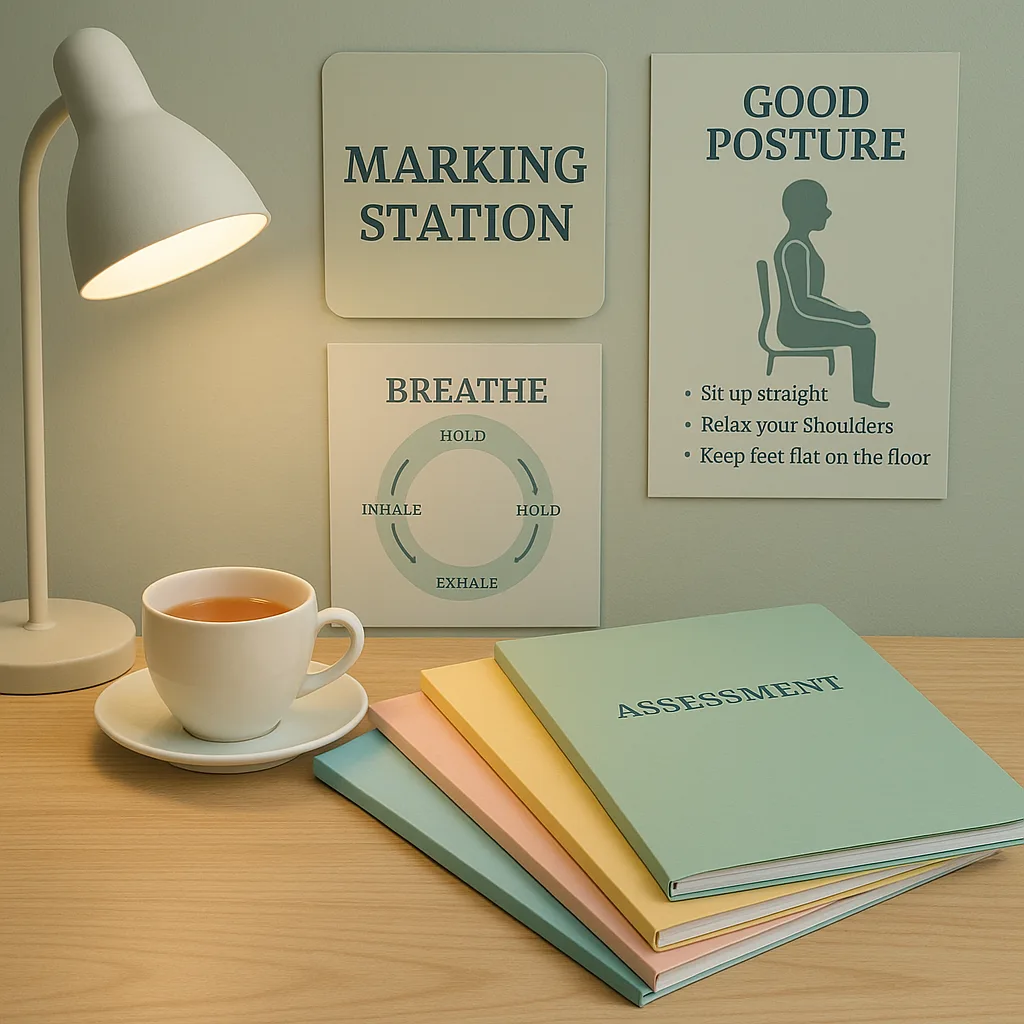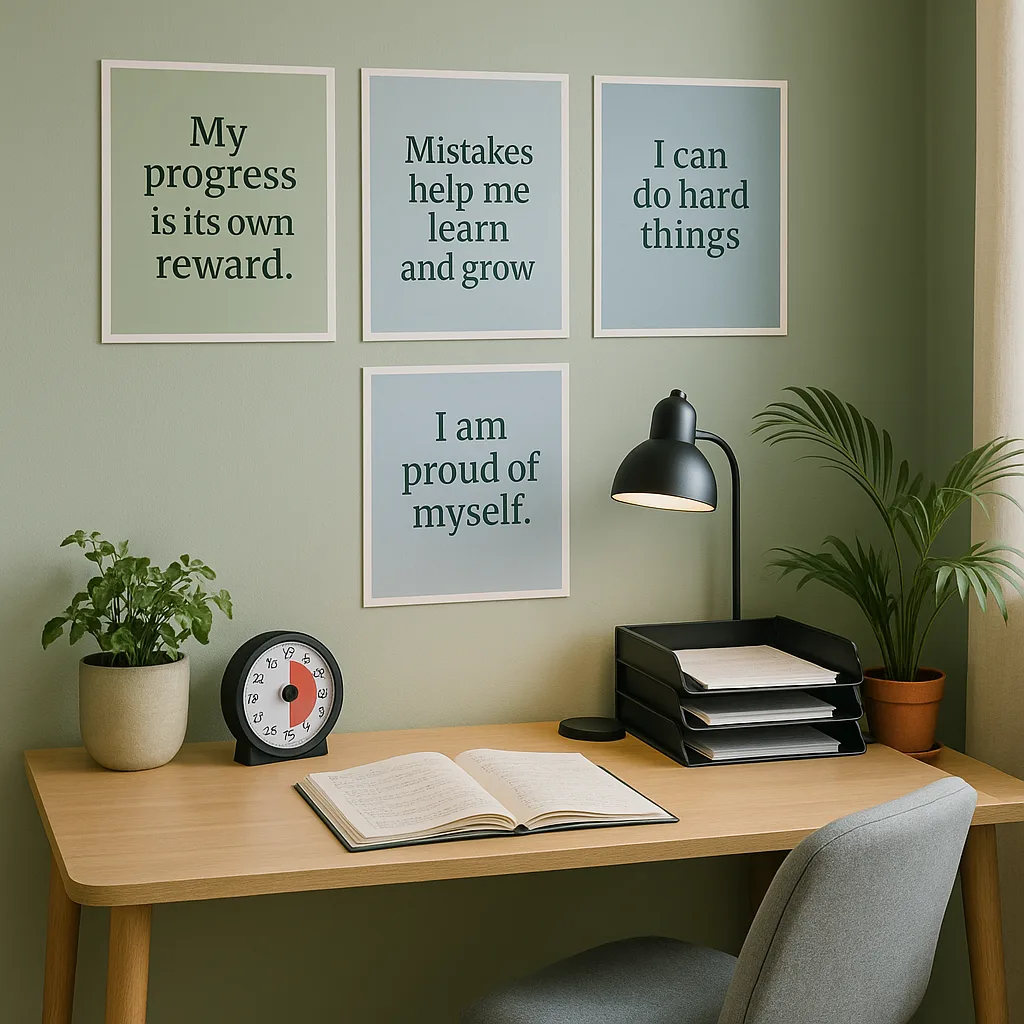Teacher Poster Maker for Mindful Marking Stations
Understanding the Psychology of Assessment Stress
Picture this: It’s Sunday evening, and you’re facing a mountain of essays. Your shoulders tense, your breathing becomes shallow, and that familiar knot forms in your stomach. This physical response isn’t just “part of the job” – it’s your body’s stress response to an overwhelming cognitive load combined with environmental factors we often overlook.
Research from the Journal of Educational Psychology shows that teachers spend an average of 10-15 hours per week on assessment tasks outside of regular school hours. When we consider the environments where this marking happens – cluttered kitchen tables, dimly lit home offices, or noisy staff rooms – it’s no wonder we feel drained. However, environmental psychology tells us that our surroundings profoundly impact our cognitive function, emotional state, and overall productivity.
By creating dedicated mindful marking stations enhanced with strategic visual elements from tools like the Campus Pro 24 Poster Maker, we can transform grading from a dreaded chore into a more manageable, even meditative practice. These visual environments work on multiple levels – reducing cognitive load, providing emotional support, and creating physical comfort that sustains us through long marking sessions.

Did You Know?
Visual environments can reduce stress hormones by up to 23% during cognitive tasksThe Science
Studies show that purposefully designed workspaces with calming visuals, proper lighting, and organized layouts significantly impact cortisol levels and improve focus duration. This isn’t just theory – it’s measurable biological change that directly affects our marking efficiency and emotional well-being.Teacher Poster Maker Mindful Marking: Essential Design Elements
Teachers report improved focus with organized visual environments
Reduction in marking-related anxiety with calming visuals
Increase in grading efficiency with proper ergonomics
Teachers maintain better posture with visual reminders
Color Psychology for Focused Assessment
The colors surrounding us during marking sessions profoundly influence our mental state and productivity. Through years of working with educators, I’ve witnessed the transformative power of intentional color choices in assessment environments. Let me share what neuroscience tells us about optimal color palettes for grading tasks.
Soft Greens and Blues: These hues activate our parasympathetic nervous system, promoting calm focus. Research from the University of British Columbia found that blue environments enhance creative performance and attention to detail – exactly what we need when providing thoughtful feedback. Consider creating posters with soft sage or seafoam backgrounds using specialized media that maintain color integrity.
Warm Neutrals: Beiges, soft grays, and warm whites create a grounding effect without overwhelming our visual cortex. These colors reduce eye strain during extended marking sessions while maintaining alertness. I often recommend teachers use banner printing machines to create large-scale neutral backdrops for their marking stations.
Strategic Accent Colors: Small pops of energizing colors like coral or golden yellow can provide motivation without overstimulation. Use these sparingly in affirmation posters or timer displays to maintain engagement without inducing stress.
Time Management Visual Aids for Assessment Tasks
One of the greatest sources of marking stress is the feeling that time is slipping away uncontrolled. Visual time management tools can transform this anxiety into empowered productivity.
The data above shows the typical efficiency improvement teachers experience when implementing mindful marking stations over a 12-week period. Notice how the initial weeks show gradual improvement as new habits form, followed by more significant gains as the environment becomes internalized.
Visual Timer Displays: Create large-format timer posters using your teacher poster maker that break marking sessions into manageable chunks. The Pomodoro Technique works exceptionally well – 25 minutes of focused marking followed by a 5-minute mindfulness break. Design these timers with calming imagery and gentle color transitions.
Progress Tracking Walls: Nothing reduces anxiety like visible progress. Design a marking progress chart that allows you to physically check off completed assignments. This visual representation provides dopamine hits that sustain motivation through long grading sessions. The tactile act of marking progress engages multiple senses, reinforcing accomplishment.
Deadline Visualization Boards: Instead of keeping all deadlines in your head (a major stress contributor), create a visual deadline board. Use color-coding to indicate urgency levels without inducing panic – soft oranges for upcoming deadlines, gentle blues for future tasks.
Practical Implementation: Your 30-Day Transformation Plan
Let’s move from theory to practice. Here’s a structured approach to creating your mindful marking station using visual tools and banner printing machines effectively.
Week 1: Assessment and Planning
Begin by documenting your current marking habits. Where do you grade? What times feel most stressful? Which physical discomforts arise? Use this data to identify your primary needs. Perhaps you need better posture reminders, or maybe time management is your biggest challenge.
Week 2: Design and Creation
Based on your assessment, design 3-5 key posters for your marking station. Start with:
• One ergonomic reminder poster
• One time management visual
• One personal affirmation display
The Campus Pro 44 Poster Maker Elite Package provides everything needed to create professional-quality visuals that will last throughout the school year.
Week 3: Environmental Setup
Install your visual elements thoughtfully. Position ergonomic reminders at eye level, place affirmations where you’ll see them during difficult moments, and ensure time management tools are easily visible without being distracting.
Week 4: Habit Integration
Focus on building new marking rituals. Start each session by reading your affirmation, use your visual timer consistently, and practice the posture adjustments shown in your ergonomic guides. Remember, it takes 21-30 days to form a new habit, so be patient with yourself.
Advanced Strategies for Teacher Poster Maker Mindful Marking
As you become comfortable with basic mindful marking practices, consider these advanced strategies that leverage visual design for even greater impact.
Seasonal Adaptation: Our needs change throughout the school year. Create seasonal poster sets that address specific challenges – energizing visuals for winter months, cooling themes for spring stress, and celebration-focused designs for end-of-year assessments. The flexibility of having your own teacher poster maker means you can adapt your environment as needed.
Student Feedback Integration: When students provide positive feedback about your marking comments, create visual reminders of these successes. Print excerpts from thank-you notes or improved student work samples. These serve as powerful motivators during challenging grading sessions, reminding you of the real impact of your assessment efforts.
Mindfulness Cue Cards: Design a set of smaller mindfulness prompt cards that can be rotated weekly. These might include breathing exercises, quick stretches, or gratitude prompts specifically tailored to marking scenarios. Having variety prevents habituation and keeps the practice fresh.
Collaborative Rubric Displays: Transform your rubrics into visually appealing wall displays. This not only aids consistency in grading but also reduces cognitive load by keeping criteria visible. Use color-coding and icons to make rubrics more intuitive and less text-heavy.
Your Wellness Journey Starts Here
Remember, creating a mindful marking station isn’t about perfection – it’s about progress. Each visual element you add, each ergonomic improvement you make, and each moment of mindfulness you cultivate contributes to your overall well-being. You deserve to feel supported and energized while doing the important work of assessment.
As you embark on this journey, know that you’re not alone. Thousands of educators are discovering how strategic visual environments can transform their grading experience. Whether you’re using a simple Classroom Pro setup or a more comprehensive printing solution, the key is to start where you are and build gradually.
Your students benefit when you’re at your best. By investing in your marking environment, you’re ultimately investing in the quality of feedback and support you can provide. That’s the beautiful ripple effect of teacher self-care – it extends far beyond our own well-being to touch the lives of every student we assess.
Take the First Step Today
Creating your mindful marking station doesn’t require a complete overhaul. Start with one visual element this week – perhaps a calming color poster or a simple affirmation. Notice how it feels to grade in the presence of intentional, supportive visuals. Then build from there, adding elements as you discover what best supports your unique needs.
Your well-being matters. Your comfort matters. And yes, even your joy in the marking process matters. Because when we feel good, we do good – and that’s exactly what our students deserve.

